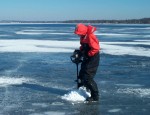Residents of Madison, Wisconsin expect their lakes to have thick hard ice for ice fishing, skating, and ice boating during mid-winter.
This year, the ice in some area lakes is not safe. NTL-LTER researchers during their routine sampling noticed that while the top layer of the ice was hard, the majority of the underlying ice was soft and spatially variable in thickness.
This was because water temperatures right under the ice were relatively warm, an effect believed to be caused by the combination of a lack of snow cover and ice-free areas that opened up during an earlier warming period.
Without the reflective snow, the ice and underlying water was heated by the sun’s radiant energy.
In addition, open holes on some of the shallower lakes that did not completely freeze over in early winter have allowed the wind to mix the water column bringing the warmer bottom water to the surface.
The end result of these relatively warm surface water temperatures has been a premature melting of the ice from underneath even though recent air temperatures have been cold.
These unusual lake ice and water temperature conditions prompted LTER researchers to contact government authorities, who in turn notified the public about unsafe ice conditions, especially with warmer weather in the immediate forecast.
The unusual ice conditions are also consistent with LTER research findings that winter ice duration on water bodies throughout the world is becoming shorter in response to global warming.

 Enlarge this image
Enlarge this image